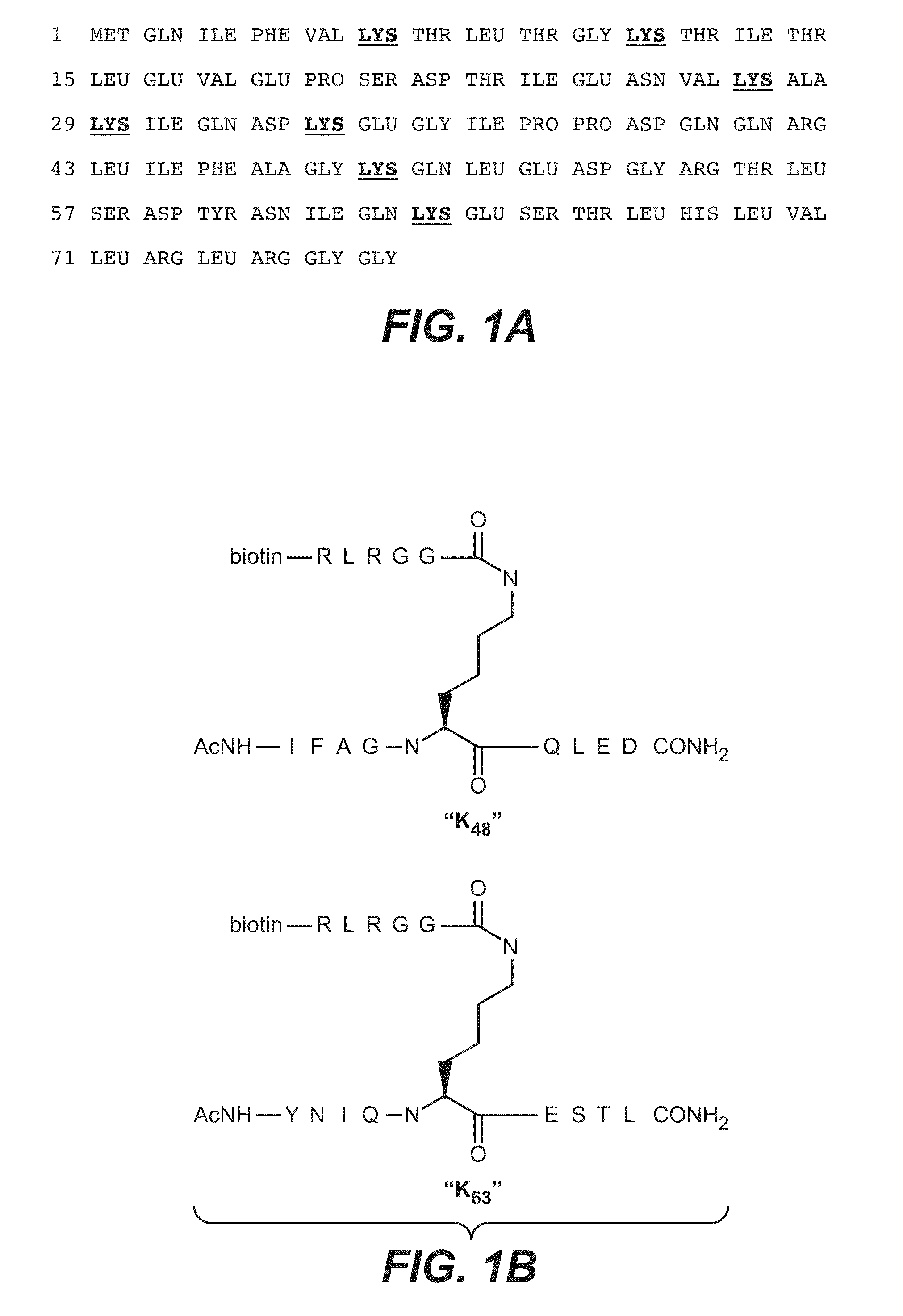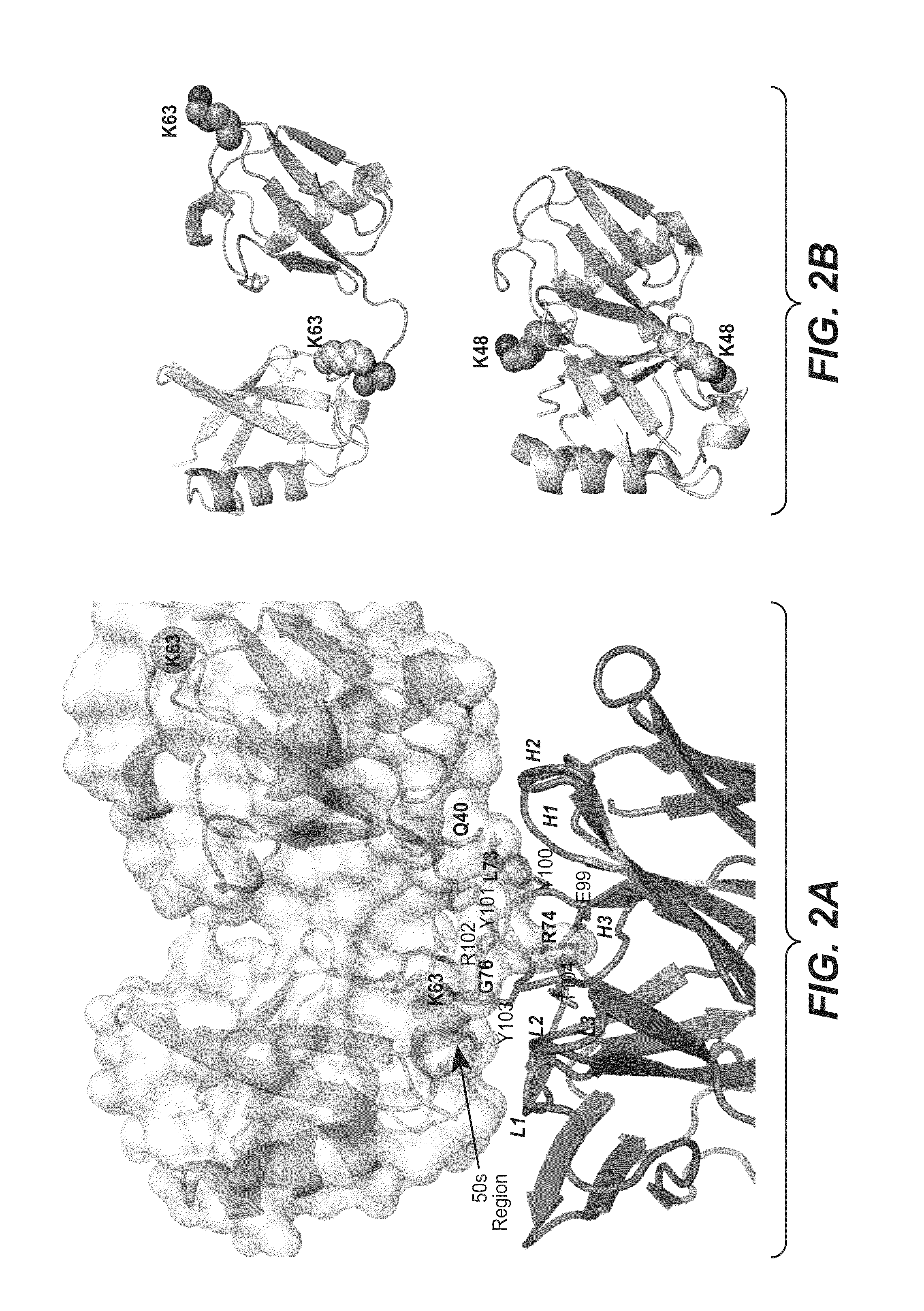Methods and compositions for targeting polyubiquitin
a polyubiquitin and polyubiquitin technology, applied in the field of antipolyubiquitin antibodies, can solve the problems of affecting the normal physiological behavior of the lysine-linked polyubiquitin, affecting the normal cellular proteolytic processing system, and each of the methodologies is ill-suited or cumbersome for analysis of normal physiological behavior,
- Summary
- Abstract
- Description
- Claims
- Application Information
AI Technical Summary
Benefits of technology
Problems solved by technology
Method used
Image
Examples
example 1
Affinity Maturation of a K63-Linked Diubiquitin-Specific Antibody Fragment
[0378]Panels of antibodies able to discriminate between K48-linked polyubiquitin and K63-linked polyubiquitin were described in US Patent Publication No. US2007-0218069, incorporated by reference herein in its entirety. The affinity and specificity of the best anti-K63-linked Fab identified in that publication (Apu2.16, Kd of approximately 100 nM and a small amount of artifactual binding to K48-linked polyubiquitin) was inferior to the affinity and specificity of the best anti-K48-linked Fab identified in that publication (Apu2.07, Kd of approximately 1 nM, no observed binding to K63-linked polyubiquitin). An improved K63-linked polyubiquitin-specific Fab / antibody was sought to facilitate applications in which greater specificity or affinity of the Fab / antibody would be desirable.
[0379](A) Library Generation
[0380]The Apu2.16 anti-K63-linked diubiquitin antibody fragment (Fab) was subjected to mutagenesis in or...
example 2
Detection of Endogenously Ubiquitinated Proteins
[0396]The activity of the affinity-matured anti-K63-linked polyubiquitin IgGs described in Example 1(F) was assessed. For western blot analyses, polyubiquitin or polyubiquitinated proteins were run on polyacrylamide gels and the contents of the gels were transferred to nitrocellulose blots following standard procedures in the art. The resulting nitrocellulose blots were blocked for approximately an hour in 10 mM Tris-HCl pH 7.5, 150 mM NaCl, 0.1% Tween-20 (TBST) containing 5% non-fat milk powder. The primary anti-K63-linked polyubiquitin antibody (either the parental Apu2.16 antibody in IgG format, or Apu3.A8, Apu3.A12, or Apu3.B3 in IgG format) was added to a final concentration of 5 μg / mL for a minimum of 1 hour at room temperature. Overnight incubations were performed at 4° C. The blots were washed three times in TBST, 10 minutes per wash. Bound anti-K63-linked polyubiquitin antibodies were detected with peroxidase-conjugated anti-h...
example 3
Ubiquitination Pathway Detection Using Affinity-Matured Antibodies
[0406]A number of cellular pathways have been identified that are regulated by polyubiquitination of key proteins. The affinity-matured anti-K63-linked polyubiquitin antibodies of the invention were used to determine the extent of K63-linked polyubiquitination of particular proteins in the cell, helping to elucidate cellular signaling pathways where ubiquitination with K63-linked polyubiquitin plays a role.
[0407](A) TNFα Activation of TNFR1
[0408]TNFα activation of tumor necrosis factor receptor 1 (TNFR1) leads to RIP and TRAF2 association (see FIG. 8A). TRAF2 adds K63-linked polyubiquitin chains to RIP which allows recruitment of TAK1 / TAB2 / TAB3 and subsequent activation of the NFκB signaling pathway (see Wertz et al., Nature (2004) 430: 694-699). Downregulation of signaling through this pathway occurs by the deubiquitinase A20 removing the K63-linked polyubiquitin chains on RIP and replacing them with K48-linked polyu...
PUM
| Property | Measurement | Unit |
|---|---|---|
| temperature | aaaaa | aaaaa |
| pH | aaaaa | aaaaa |
| flow rate | aaaaa | aaaaa |
Abstract
Description
Claims
Application Information
 Login to View More
Login to View More - R&D
- Intellectual Property
- Life Sciences
- Materials
- Tech Scout
- Unparalleled Data Quality
- Higher Quality Content
- 60% Fewer Hallucinations
Browse by: Latest US Patents, China's latest patents, Technical Efficacy Thesaurus, Application Domain, Technology Topic, Popular Technical Reports.
© 2025 PatSnap. All rights reserved.Legal|Privacy policy|Modern Slavery Act Transparency Statement|Sitemap|About US| Contact US: help@patsnap.com



